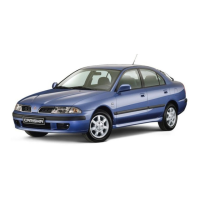STARTING AND DRIVING
5–27
Braking
EI23AAFc
All the parts of the brake system are critical
to safety. Have the vehicle serviced by an
authorized MITSUBISHI dealer at regular
intervals according to the service booklet.
Brake system
(1) The service brake is divided into two
brake circuits so that when one brake
circuit fails, the other is available to
stop the vehicle. If this occurs, howev-
er, the brake pedal must be depressed
further than usual; stop driving as
soon as possible and have the brake
system repaired at the nearest autho-
rized MITSUBISHI dealer.
(2) The brake boosting force is lost after
the brake pedal is depressed once or
twice while the engine is off. If this oc-
curs, the brake will require greater
force than usual. This is especially im-
portant when the vehicle is being
towed.
Warning lamp
The brake warning lamp lets you know if
your brake system is working properly.
Read “Brake warning lamp” on page 4–8 .
When brakes are wet
Check the brake system while driving at a
low speed immediately after starting, es-
pecially when the brakes are wet, to con-
firm they work normally.
A film of water can form on the brake discs
and prevent normal functioning after driv-
ing in heavy rain or through large puddles,
or after the vehicle is washed. If this oc-
curs, dry the brakes out by driving slowly
while lightly depressing the brake pedal.
When driving downhill
It is important to take advantage of the en-
gine braking by shifting to a lower gear
while driving on steep downhill roads in or-
der to prevent the brakes from overheat-
ing.
Brake pads
(1) With new brake pads, avoid where
possible sudden full application of the
brakes for the first 200 km of driving.
(2) The disc brakes are provided with a
warning device which emits a shriek-
ing metallic sound while braking if the
brake pads have reached their limit. If
you hear this sound, have the brake
pads replaced by your MITSUBISHI
dealer.
CAUTION
(1) Do not leave any objects or place
a thick floor mat around the brake
pedal; doing so could prevent the
full pedal stroke that would be
necessary in an emergency.
Make sure that the pedal can be
operated freely at all times.
(2) Avoid driving habits that cause
heavy braking and never “ride”
the brakes by resting your foot on
the brake pedal while driving.
It causes brake overheating and
fade.

